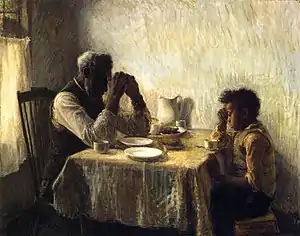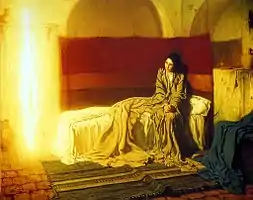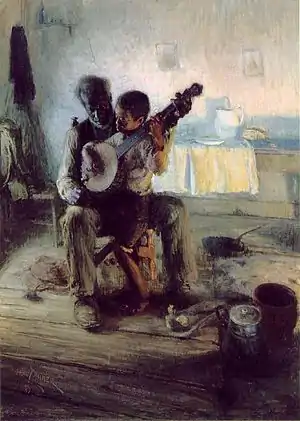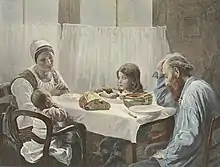The Thankful Poor
The Thankful Poor is an 1894 painting by African-American painter Henry Ossawa Tanner. It depicts black family members praying at a table and has been praised as a "milestone" for its portrayal of African Americans.[1]
| The Thankful Poor | |
|---|---|
 | |
| Artist | Henry Ossawa Tanner |
| Year | 1894 |
| Medium | oil on canvas |
| Dimensions | 90.3 cm × 112.5 cm (35.6 in × 44.3 in) |
| Owner | Camille O. and William H. Cosby |
Description


The painting depicts an old man and a young boy, perhaps a grandfather and his grandson, at a table, praying before their meal. The effect of the painting's soft light creates an intimate atmosphere, highlighting the familial bonds between the two subjects.[1]
There is only one source of light, the window behind the old man with sheer curtains. To the left, the man sits on a high-backed chair with his elbows on the table and his hands clasped before his face in prayer. The boy sits on a low bench or crate on the other side of the table, with one hand held to his head emulating the man's prayerful pose. The table is set with a tablecloth, two white plates and cups, a large white pitcher, cutlery, and small portions of food. The setting is humble but not impoverished: while the meal appears meagre, the table has a clean tablecloth. On the reverse of the painting is an early study for Tanner's 1895 painting The Young Sabot Maker.
The calm depiction of everyday Christian devotions in a modest domestic setting, perhaps saying grace or the Lord's prayer, counters contemporary perceptions of Black religiosity as primitive and emotional, derived from tribal ritual and superstition, in distinction to the more advanced, introspective, contemplative and meditative White religiously.
The domestic location and the two subjects, and old man and a young boy, are similar to those in The Banjo Lesson (another painting by Tanner), which depicts the young boy being taught to play the banjo by the old man. Notably, neither painting shows a mature black man in the prime of life. Both paintings were based on staged photographs that Tanner took in Atlanta, probably while he was running a photography shop from 1889 to 1891, before moving to Paris. Both paintings were made after he returned temporarily to the U.S. in 1893 to recuperate after suffering from typhoid fever, before moving back to Paris in 1894.
Analysis
Before completing The Thankful Poor in 1894,[2] Tanner made a study for the painting that is now held at the DuSable Museum of African American History in Chicago, Illinois.[3]
Many of Tanner's paintings - including The Thankful Poor - were internationally known for their religious themes, such as his 1898 painting The Annunciation[4] and his 1902–1903 painting The Good Shepherd.[1] In such paintings, Tanner depicts his subjects and their environment with an expressive realism,[5] seeking to "give the human touch" through naturalistic interpretations.[6] Though carrying religious undertones, The Thankful Poor does not portray a biblical subject. Rather, it is a genre painting of a daily ritual experience for lower-class African Americans. In both The Thankful Poor and his most famous genre painting The Banjo Lesson, painted the previously year, Tanner chose to capture the hardships of African-American life through a realistic scene.[2]
Tanner's stylistic choice for his genre paintings marks a clear break from the derogatory caricatures of African Americans typical of the late 19th century.[2][7] The subject may reflect the particular reverence for Thankgiving Day of the African Methodist Episcopal Church, in which Tanner's father was bishop.
The composition may draw inspiration from the 1891 painting Le Repas en Famille (The Family Meal) by Elizabeth Nourse, which won a gold medal at the 1893 World's Columbian Exhibition. There are clear parallels in European art, such as Jan Steen's 1660 painting The Prayer before the Meal.
 Jan Steen, The Prayer before the Meal, 1660
Jan Steen, The Prayer before the Meal, 1660 Elizabeth Nourse, Le Repas en Famille (The Family Meal), 1891
Elizabeth Nourse, Le Repas en Famille (The Family Meal), 1891
Reception
The completed painting was exhibited with The Banjo Player in the spring of 1894 at the James S. Earle and Sons Gallery in Philadelphia, Pennsylvania.[2] On his return to Paris, The Banjo Lesson was his first work to be accepted at the Paris Salon in 1894. Despite his success, Turner turned away from depictions of African-Americans, finding more critical and commercial success with landscape paintings and biblical scenes. The Thankful Poor is Tanner's last known work depicting African-American subjects.
In 1970, the painting was discovered in a storage closet in the Pennsylvania School for the Deaf by headmaster Dr. Philip Bellefleur; it was given on loan to the Philadelphia Museum of Art before being sold in 1981 to comedian Bill Cosby and his wife Camille for $250,000.[8] As of 2014, the painting remains in the Camille O. and William H. Cosby Collection of African American Art.[9] In 2016, the painting was featured in an exhibition called the DuSable Masterworks Collection at the DuSable Museum. The exhibit celebrated the works of African-American artists like Tanner from the late 19th to the mid-20th centuries.[10]
According to the catalogue of a 1991 exhibition of Tanner's work held at the Philadelphia Museum of Art, the painting's "dignified portrayal of the old man and boy at prayer...transcends any other image of black Americans in American art". The artistic and cultural significance of the painting has led some to describe it as a "milestone" in the history of African-American art.[1]
References
- "Spiritualities". Conversations. Smithsonian National Museum of African Art. Retrieved January 15, 2021.
- "'Real' Experiences and Upended Stereotypes: Henry Ossawa Tanner's Black Genre Scenes". Princeton University. Retrieved January 15, 2021.
- "Study for the Thankful Poor". Google Arts and Culture. Retrieved January 15, 2021.
- "The Annunciation". Philadelphia Museum of Art. Retrieved January 15, 2021.
- "Henry Ossawa Tanner". Smithsonian American Art Museum. Retrieved January 15, 2021.
- Hage, Emily (March 19, 2012). "Making the Modern Divine: The images of Henry Ossawa Tanner". America. Retrieved January 15, 2021.
- Mann, Lisa. "Diversity in White House Art: Henry Ossawa Tanner". The White House Historical Association. Retrieved January 15, 2021.
- Skeel, Sharon Kay (February–March 1991). "A Black American In The Paris Salon". American Heritage. Vol. 42 no. 1. Retrieved January 15, 2021.
- Cotter, Holland (November 6, 2014). "Continents in Conversation". The New York Times. Retrieved January 15, 2021.
- "New exhibit celebrates artists who broke color barrier". WLS-TV. Chicago. February 22, 2016. Retrieved January 15, 2021.
Sources
- "'Henry Ossawa Tanner's Negotiation of Race and Art: Challenging "The Unknown Tanner", Naurice Frank Woods Jr., Journal of Black Studies, Vol. 42, No. 6 (September 2011), pp. 887-905
- Judith Wilson, “Lifting “The Veil”: Henry O. Tanner’s The Banjo Lesson and The Thankful Poor,” Contributions in Black Studies: vol. 9, article 4 (1992)
- "An African American Artist Finds His Voice in Paris During the 19th Century", Rae Alexander-Minter, Présence Africaine, Nouvelle série, No. 171 (1er semestre 2005), pp. 119-132
- Poverty in American Popular Culture: Essays on Representations, Beliefs and Policy, Wylie Lenz, McFarland, 2020 ISBN 1476639035, pp.27-40